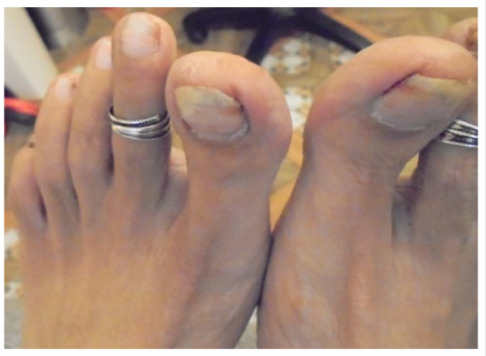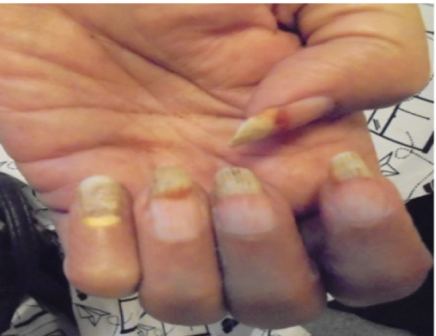Onychomycosis T/T Using a Q Switched Ndyag Laser in Itraconazole Resisitant Cases in India
Amarendra Pandey1, Sidharth Sonthalia2*, Biplav Agarwal 3
1Consultant Aesthetic Dermatologist & Laser Surgeon, COSMASURE, Jabalpur, India.
2Consultant Dermatologist & Dermatosurgeon, SKINNOCENCE: The Skin Clinic & Research Centre, Sushant Lok-1, Gurugram, India.
3Consultant Dermatologist & Laser Surgeon Adorn Ahemdabad, Gujarat, India.
*Correspondence Author: Sidharth Sonthalia, Consultant Dermatologist & Dermatosurgeon, SKINNOCENCE: The Skin Clinic & Research Centre, Sushant Lok-1, Gurugram, India, Tel: +91 9871469913; Fax: +91 9871469913; E-mail: sidharth.sonthalia@gmail.com
Citation: Amarendra Pandey, Sidharth Sonthalia, Biplav Agarwal (2022) Onychomycosis T/T Using a Q Switched Ndyag Laser in Itraconazole Resisitant Cases in India. Allergy drugs clin Immunol 4: 119. .
Copyright: © 2022 Sidharth Sonthalia, et al. This is an open-access article distributed under the terms of the Creative Commons Attribution License, which permits unrestricted use, distribution, and reproduction in any medium, provided the original author and source are credited.
Received date: March 27, 2022; Accepted date: April 07, 2022; Published date: April 10, 2022.
Abstract
The first question which comes to mind is why on earth use lasers for onycomycosis?,well, the anser lies in the fact that especially in india onycomycosis and dermatophytosis has become highly resiatant and reccurent due to large scale and rampant itraconazole abuse and injudicious use of pesticides ,hence in thi syudy of 20 patients we have used the free running or micro-second pulse and normal mode of the Q Switched NDYag nanosecond laser to treat itraconazole resistant onycomycosis .Itraconazole is available by more 792 brand names in india and only a handful are trustworthy in our opinion. Widespread resistance are like human time bombs waiting to infect others and make this disease even more widespread, Dermatophytosis and Onycomycosis are fully recurrent and chronic now in India.
Keywords
Q-Switched Nd: YAG, Resistant Onycomycosis,Lasers in Onycomycosis ,Itraconazole Resistance.
Introduction
Onychomycosis accounts for 30% of all dermatophyte infections and accounts for 18%–40% of all nail disorders this is general data as avalible Its prevalence is much higher in specific populations such as in diabetes mellitus,elderly and the the immunosuppressed. Onychomycosis can be nondermatophytic (1%) and dermatophytic (99%) The dermatophytes trichophyton rubrum and trichophyton mentagrophytes are the most common causative pathogens responsible for up to 90% of all cases among the nondermatophytes, the yeast candida albicans, candida tropicalis, and aspergillus, and other molds may be responsible however now Mixed infections are being increasingly encountered.
Toe Nail Onychomycosis
In recent times, both fractional ablative lasers and QS lasers have been successfully used as innovative treatment modalities for toe nail onychomycosis. Laser has been used as a stand-alone therapy as well as in combination with topical and/or oral antifungals [12-14]. The 1024 nm long-pulsed Nd: YAG laser has been found highly efficacious in this regard [13,14].
The Helios III QSNY laser utilizes the principle of multi-layered bulk heating of the fungus-infected nail plate and matrix, thereby providing fungicidal effect as well as enhancing the subsequent penetration of topical antifungal lacquers. The procedure is painful. For laser treatment of onychomycosis of toe nails, the fractional and zoom hand-pieces are used. This approach is useful for patients who are intolerant or otherwise non-candidates for oral.
Toenails are far more likely to be involved than fingernails.
In addition to the cosmetic concerns of the patients, onychomycosis is a serious medical problem that can be the source of recurring fungal infections of surrounding tissues.
Also, it may predispose patients to secondary bacterial infections leading to localized paronychia and perhaps worse and deeper infections such as erysipelas-cellulitis, diabetic foot etc., especially in the high-risk groups such as diabetics.
Clinically it can cause varying degrees of pain or discomfort (especially in walking) and problems in cutting nails.
Rationale of using lasers:
- Suboptimal penetration of topicals
- Inadequate drug levels achieved by systemic drugs
- BIOFILM formation-induced PHARMACOLOGICAL RESISTANCE
- ITRACONAZOLE MENACE - indiscriminant and injudicious use of itraconazole being produced by propaganda companies prescribed by all kinds of quacks in improper dosages and periods which has led to the emergence of MULTI-DRUG RESISTANT “super onycomycosis” on which no conventional therapy works.
Patients typically report after having taken itraconazole 200 mg bd for 4-6 months, with persistent disease and visible matrix damage.
Lasers in Onycomycosis – Basic Rationale:
Temperatures over 45°C (fluence of >16 J/cm2) can result in pain and necrosis in humans, whereas fungicidal temperatures occur at 50°C. Fungal cells and dermal cells differ in membrane conductivity and water content. As these dermal structures have a higher thermal conductivity, heat can be easily dissipated. Fungal cells, however, do not have this property and can therefore be targeted. The mycelium surrounded by the chitin wall is slow to dissipate heat between successive pulses, resulting in a buildup of temperature within the mycelium, unlike the surrounding tissue where heat is conducted away by tissue and water.
Nd: YAG LASERS For ONM:
- MOA – Selective photothermolysis
- Fungal chromophores for Nd:YAG lasers – xanthomegnin, melanin
- Chromophores absorb enough heat - shifted to the fungal tissue - elevation of the tissue temperature - damage of the fungi.
- Nd:YAG lasers can effectively reach the depth of the nail bed, the site of the fungus colony.
- The surface temperature is controlled on 43∼51 °C, which is curative for ONM. Table 1.
Table 1: Comparison of other studies relating to lasers in onycomycosis. -
Authors
Laser
Patients/Nails
Treatment Duration
Outcomes
Horine et al.
Pinpointe short-pulsed 1064 nm Nd: YAG
262 patients
One treatment per infected nail
Becker and Bershow
1064 nm Nd: YAG
72 patients
Four treatments; one week between sessions
95, 8% clinically clear and culture negative at 3/12 follow up
1064 nm Nd: YAG
8 patients
Every three weeks for three sessions (3; 6; 9)
Seven out of eight patients culture negative after third treatment
Note: Topical antifungal prescribed after first tratment
1064 nm Nd: YAG
37 toenails
Up to three treatments
16 weeks follow up 81% exhibited moderate to complete clearance
Birstow
Noveon continuous wave 830 nm/930 nm
37 toenails (26 treated; 11 control)
One treatment per infected nail
6/12 follow up;
Complete clearance/markedly improved: 2 treated nails VS. 2 controls
Slight/moderate improvement: 18 treated nails VS. 3 controls
Unchanged: 6 treated nails VS. 6 controls
Lasers in Onm - Evidence
- Mycological cure (microscopy and culture) found across laser studies in the literature is 11%4, using patients as a unit of analysis and 63% using nails as the unit of analysis.
- Complete cure (mycological cure and 100% clear nail) found across laser studies is 50% as evaluated using nails as the unit of analysis.
- In studies that evaluated the efficacy of lasers in toenail onychomycosis, complete cure has not been reported using the number of patients as the unit of analysis.
Materials and Methods
Subjects: Eligible participants were total 20 patients of which there were 12 males and 8 female patient’s p who were between the age group of 35-65 years of age who had onycomycosis for more than a year, all had undertaken itraconazole in random doses, some had self-medicated also, 4 of these were uncontrolled diabetics and in all cases even after propr dosage of Itaconazole was initiated still there was no improvement in the disease.
Procedure: We have used HELIOS III – A fractionated QSND: YAG nanosecond laser with separate fractional 532 hand piece modality, we start with fractionated 1064 FR mode energies 1500-2000 J, 4-5 Passes dependent on patient tolerability. We use zoom hand piece - 1064 spot size. 3,4,5 circular motion - multiple passes energies 1200-1500 J in FR, free running mode. end point - mild white change in colour, in extensive cases 1064 zoom handpiece - spot size - 5 nano second pulse - energy 700-900 J - endpoint deep white ppt, lastly 532 fractionated de focussed energy at 160-200 is given dependent on patient tolerability.
All the patients were then managed on weekly doses of fluconazole ranging from 150-200 mg weekly and on amorolfine nail lacquer twice weekly and proper nail hygiene instructions were given.
The study was cleared by the ethics committee of our institution and was conducted in accordance with the ethical principles of the 1975 declaration of Helsinki and in compliance with the good clinical practice guidelines.
Outcomes: We observed that in 70 percent of the cases there was a 70 percent improvement in the area of involvement of onycomycosis and the progression arrested completely, even in the remainder 20 percent who had uncontrolled sugar the progression of the disease arrested and an improvement of 50 %-70% was observed, 10 percent of the patients were non-compliant and lost to follow up.
Tolerability/Safety Results
- Mild to moderate pain was experienced by 50 % of the patients
- Severe pain was experience immediately after therapy in 5 % of the patients which subsided with analgesics and did not reoccur.
- Patients were asked to report back with any other adverse effects but none were reported.
There were no serious adverse effects or long term side effects reported in this study.
About the technology
Helios III is the latest innovative fractional” QSNY laser from Korea. The Helios III laser system is based on the Nd:YAG (1064 nm) and frequency doubled KTP Nd:YAG (532 nm) laser technology. The three basic elements of its operations include – (a) Nd:YAG crystal used as a gain medium, which produces a laser beam, (b) a resonator then amplifies the beam, and (c) a lamp that contains Xenon gas that is used as a pumping light source [4]. The regulation of laser output and repetition rate can be set by the user via GUI (Graphic User Interface) and controlled by microprocessor, which interfaces with the power supply.
Helios III has five modes and four hand-pieces. It fractional handpiece was developed with diffractive optical element (DOE), a new patented technology that releases micro beams (instead of the erstwhile bulk beams of energy) that stimulate minimally thereby minimizing the possibility side effects.
Pitfalls and limitations:- This study due to financial restraints could not include detailed nail dermatoscopy and histopathological studies.
- QSNY laser has no consumables so affordability can be customized.
- We, the laser surgeons should keep it within the reach of all strata of the society by keeping our rates relatively economical, packages must be the norm. We are becoming the last hope for ONM.
- Its an OPD procedure.
- It’s a relatively quick and easy procedure with demonstratable end points and feedback checks from the patients.
- No anesthesia is required.
- It indeed provides a ray of hope for all dermatologists in the pharmaceutical hazard and impending epidemic which looms large.










Acknowledgments
None
Disclaimer
“We confirm that the manuscript has been read and approved by all the authors, that the requirements for authorship as stated earlier in this document have been met, and that each author believes that the manuscript represents honest work”.
References
- Gupta AK, Foley KA, Versteeg SG (2017) Lasers for Onychomycosis. J Cutan Med Surg 21: 114-116.
- Rivers JK, Vestvik BJ, Berkowitz J (2017) Real-World Efficacy of 1064-nm Nd:YAG Laser for the Treatment of Onychomycosis. J Cutan Med Surg 21: 108-113.
- Kim MS, Jung JY, Cho EB, Park EJ, Kim KH, et al. (2016) The effectiveness of 1,064-nm long-pulsed Nd:YAG laser in the treatment of severe onychomycosis. J Cosmet Laser Ther18: 317-322.
